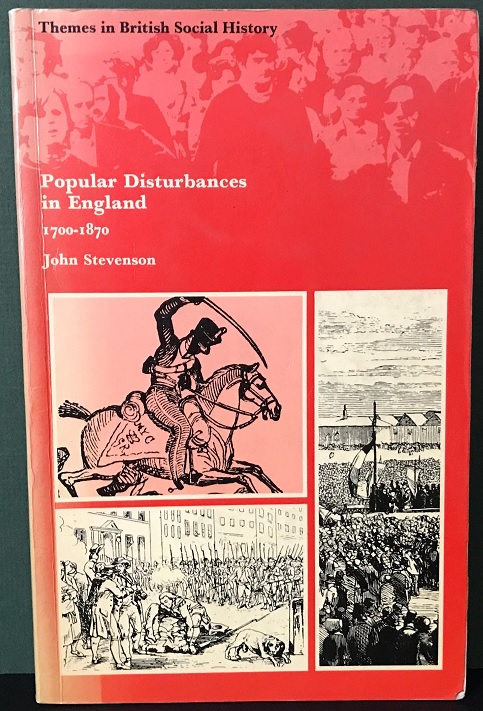Biblioteca / 1970-1979 1990-1999
John Stevenson. Popular Disturbances in England, 1700-1870.
Londres: Longman, 1979. 380 páginas.
2da edición, Popular Disturbances in England, 1700-1832, London: Longman, 1992. 350 páginas.
CONTENTS
[Edición de 1979]
Preface
1 – Introduction
2 – The age of riots
3 – Manifold disorders
4 – Eighteenth-century London
5 – Food riots in England
6 – Labour disputes before the Combination Laws
7 – The age of revolution
8 – London in the age of revolution
9 – London and the kingdom
10 – The reform struggle
11 – Unions and labourers: industrial and agricultural protest
12 – The Chartist era
13 – The transition to order
14 – Conclusion
_________________
CONTENTS
[Edición de 1992]
Preface to the first edition
Preface to the second edition
1 – Introduction
Disturbances, riots, crowds and mobs
Sources and methods
2 – The age of riots
The ‘rage of party’
The age of oligarchy
Religious riots
3 – Manifold disorders
Recruiting riots
Enclosures and turnpikes
Smugglers, wreckers and poachers
Popular disturbances and the local community
4 – Eighteenth-century London
The Sacheverell riots and popular Toryism in London
The age if Walpole
‘Independent’ Westminster
‘Wilkes and liberty!’
The Gordon Riots
5 – Food riots in England
The location of food disturbances
The participants
Types of food riot
The causes of food riots: prices and disturbances
Riots and near-riots
Famine or scarcity?
The decline of food rioting
6 – Labour disputes before the Combination Laws
The cloth-workers
The framework knitters
The keelmen
Seamen’s strikes
The colliers
The shipbuilding trades
The 1790s
The role of violence
7 – The age of revolution
Church and King riots
Popular radicalism and popular disorder
Industrial disputes under the Combination Laws
The Luddites
8 – London in the age of revolution
The Westminster elections
The impact of the French Revolution
The anti-crimp-house riots
The LCS and opposition to the war
Bread or blood!
Despard and the insurrectionary tradition
9 – London and the kingdom
Burdett and liberty
The passing of the Corn Laws
The insurrectionary tradition: from Spa Fields to Cato Street
The Queen Caroline Affair
10 – Unions and labourers: industrial and agricultural protest
The rise of the unions
Captain Swing
11 – The reform struggle
Waterloo to Peterloo
Peterloo and after
The reform crisis
12 – Conclusion
The causes
Frequency and distribution
Motives and beliefs
The changing face of protest
The threat of revolution
Maps
Map 1. London in the reign of George I
Map 2. London c. 1815

